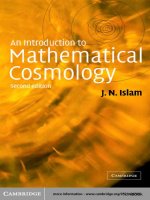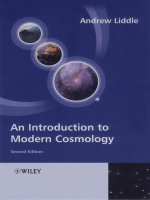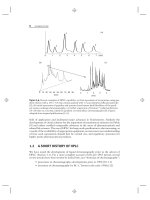- Trang chủ >>
- Khoa Học Tự Nhiên >>
- Vật lý
liddle a. introduction to modern cosmology
Bạn đang xem bản rút gọn của tài liệu. Xem và tải ngay bản đầy đủ của tài liệu tại đây (11.42 MB, 189 trang )
Second
Edition
An Introduction to
Modern Cosmology
This page intentionally left blank
An
Introduction
To
Modern Cosmology
Second Edition
Andrew
Liddle
University
of
Sussex,
UK
WILEY
Copyright
©
2003 John Wiley
&
Sons Ltd,
The
Atrium, Southern Gate, Chichester,
West
Sussex PO19 8SQ, England
Telephone (+44) 1243 779777
Email (for orders
and
customer service enquiries):
Visit
our
Home Page
on
www.wileyeurope.com
or
www.wiley.com
All
Rights Reserved.
No
part
of
this publication
may be
reproduced, stored
in a
retrieval system
or
transmitted
in any
form
or by
any
means, electronic, mechanical,
photocopying,
recording,
scanning
or
otherwise, except under
the
terms
of the
Copyright,
Designs
and
Patents
Act
1988
or
under
the
terms
of a
licence issued
by the
Copyright Licensing Agency Ltd,
90
Tottenham
Cour
Road, London
WIT
4LP,
UK,
without
the
permission
in
writing
of the
Publisher. Requests
to the
Publisher should
be
addressed
to the
Permissions Department, John
Wiley
&
Sons Ltd,
The
Atrium, Southern Gate, Chichester, West
Sussex
PO19 8SQ.
England,
or
emailed
to
,
or
faxed
to
(+44) 1243
770571.
This publication
is
designed
to
provide accurate
and
audioritative information
in
regard
to the
subject
matter covered.
It is
sold
on the
understanding that
the
Publisher
is not
engaged
in
rendering professional services.
If
professional
advice
or
other expert
assistance
is
required,
the
services
of a
competent
professional
should
be
sought.
Other
Wiley Editorial
Offices
John Wiley
&
Sons
Inc.,
111
River
Street,
Hoboken,
NJ
07030,
USA
Jossey-Bass,
989
Market Street,
San
Francisco,
CA
94103-1741,
USA
Wiley-VCH
Verlag
GmbH,
Boschstr.
12,
D-69469
Weinheim, Germany
John Wiley
&
Sons Australia Ltd,
33
Park Road, Milton, Queensland 4064,
Australia
John Wiley
&
Sons
(Asia)
Pte
Ltd,
2
dementi
Loop
#02-01,
|in
Xing Distripark, Singapore 129809
John
Wiley
&
Sons Canada Ltd,
22
Worcester Road, Etobicoke, Ontario, Canada
M9W 1L1
Wiley
also publishes
in
books
in a
variety
of
electronic
formats.
Some content
that
appears
in
may not be
available
in
electronic books.
Library
of
Congress Cataloging-in-Publication
Data
(to
follow)
British Library Cataloguing
in
Publication
Data
A
catalogue record
for
this book
is
available
from
the
British
Library
ISBN 0470 84834
0
Cloth
047084835
9
Paper
Produced
from
author's LaTeX
files
Printed
and
bound
in
Great Britain
by
Antony Rowe Ltd., Chippenham, Wilts
This book
is
printed
on
acid-free
paper responsibly manufactured
from
sustainable
forestry
in
which
at
least
two
trees
are
planted
for
each
one
used
for
paper production.
To
my
grandmothers
This page intentionally left blank
Contents
Preface
xi
Constants,
conversion
factors
and
symbols
xiv
1 A
(Very) Brief History
of
Cosmological
Ideas
1
2
Observational Overview
3
2.1
In
visible light
3
2.2
In
other wavebands
7
2.3
Homogeneity
and
isotropy
8
2.4 The
expansion
of the
Universe
9
2.5
Particles
in the
Universe
11
2.5.1
What particles
are
there?
11
2.5.2 Thermal distributions
and the
black-body spectrum
13
3
Newtonian Gravity
17
3.1
The
Friedmann equation
18
3.2 On the
meaning
of the
expansion
21
3.3
Things that
go
faster
than light
21
3.4 The fluid
equation
22
3.5 The
acceleration
equation
23
3.6 On
mass, energy
and
vanishing factors
of c
2
24
4
The
Geometry
of the
Universe
25
4.1
Flat geometry
25
4.2
Spherical geometry
26
4.3
Hyperbolic geometry
28
4.4
Infinite
and
observable Universes
29
4.5
Where
did the Big
Bang happen?
29
4.6
Three
values
of k 30
5
Simple
Cosmological
Models
33
5.1
Hubble'slaw
33
5.2
Expansion
and
redshift
34
5.3
Solving
the
equations
35
viii
CONTENTS
5.3.1 Matter
36
5.3.2 Radiation
37
5.3.3 Mixtures
38
5.4
Particle
number
densities
39
5.5
Evolution including curvature
40
6
Observational
Parameters
45
6.1 The
expansion rate
HO
45
6.2 The
density parameter
Q
0
47
6.3 The
deceleration parameter
48
7
The
Cosmological
Constant
51
7.1
Introducing
A 51
7.2
Fluid description
of A 52
7.3
Cosmological models with
A 53
8 The Age of the
Universe
57
9 The
Density
of the
Universe
and
Dark
Matter
63
9.1
Weighing
the
Universe
63
9.1.1 Counting
stars
63
9.1.2 Nucleosynthesis foreshadowed
64
9.1.3 Galaxy rotation curves
64
9.1.4 Galaxy cluster composition
66
9.1.5
Bulk
motions
in the
Universe
67
9.1.6
The
formation
of
structure
68
9.1.7
The
geometry
of the
Universe
and the
brightness
of
supernovae
. 68
9.1.8 Overview
69
9.2
What might
the
dark matter
be? 69
9.3
Dark matter
searches
72
10
The
Cosmic
Microwave
Background
75
10.1
Properties
of the
microwave background
75
10.2
The
photon
to
baryon ratio
77
10.3
The
origin
of the
microwave background
78
10.4
The
origin
of the
microwave background (advanced)
81
11
The
Early
Universe
85
12
Nucleosynthesis:
The
Origin
of the
Light
Elements
91
12.1
Hydrogen
and
Helium
91
12.2
Comparing
with
observations
94
12.3
Contrasting decoupling
and
nucleosynthesis
96
CONTENTS
ix
13
The
Inflationary Universe
99
13.1
Problems
with
the Hot Big
Bang
99
13.1.1
The flatness
problem
99
13.1.2
The
horizon problem
101
13.1.3
Relic particle abundances
102
13.2 Inflationary expansion
103
13.3
Solving
the Big
Bang problems
104
13.3.1
The flatness
problem
104
13.3.2
The
horizon problem
105
13.3.3
Relic particle abundances
106
13.4
How
much
inflation?
106
13.5
Inflation
and
particle physics
107
14
The
Initial Singularity
111
15
Overview:
The
Standard
Cosmological Model
115
Advanced
Topic
1
General
Relativistic
Cosmology
119
1.1
The
metric
of
space-time
119
1.2
The
Einstein equations
120
1.3
Aside: Topology
of the
Universe
122
Advanced
Topic
2
Classic
Cosmology:
Distances
and
Luminosities
125
2.1
Light propagation
and
redshift
125
2.2 The
observable
Universe
128
2.3
Luminosity distance
128
2.4
Angular diameter distance
132
2.5
Source counts
134
Advanced
Topic
3
Neutrino
Cosmology
137
3.1
The
massless case
137
3.2
Massive neutrinos
139
3.2.1
Light neutrinos
139
3.2.2 Heavy neutrinos
140
3.3
Neutrinos
and
structure formation
140
Advanced
Topic
4
Baryogenesis
143
Advanced Topic
5
Structures
in the
Universe
147
5.1
The
observed structures
147
5.2
Gravitational instability
149
5.3 The
clustering
of
galaxies
150
5.4
Cosmic microwave background anisotropies
152
5.4.1
Statistical
description
of
anisotropies
152
5.4.2 Computing
the Ct 154
5.4.3 Microwave background observations
155
5.4.4 Spatial geometry
156
x
CONTENTS
5.5
The
origin
of
structure
157
Bibliography
161
Numerical answers
and
hints
to
problems
163
Index
167
The
development
of
cosmology will
no
doubt
be
seen
as one of the
scientific
triumphs
of
the
twentieth century.
At its
beginning,
cosmology
hardly
existed
as a
scientific
discipline.
By
its
end,
the Hot Big
Bang cosmology stood secure
as the
accepted
description
of the
Universe
as a
whole. Telescopes such
as the
Hubble Space Telescope
are
capable
of
seeing
light
from
galaxies
so
distant that
the
light
has
been travelling towards
us for
most
of the
lifetime
of the
Universe.
The
cosmic
microwave background,
a
fossil
relic
of a
time when
the
Universe
was
both denser
and
hotter,
is
routinely detected
and its
properties examined.
That
our
Universe
is
presently expanding
is
established without doubt.
We
are
presently
in an era
where understanding
of
cosmology
is
shifting
from
the
qualitative
to the
quantitative,
as
rapidly-improving observational technology drives
our
knowledge forward.
The
turn
of the
millennium
saw the
establishment
of
what
has
come
to be
known
as the
Standard Cosmological Model, representing
an
almost universal con-
sensus
amongst cosmologists
as to the
best description
of our
Universe. Nevertheless,
it is
a
model
with
a
major
surprise
— the
belief that
our
Universe
is
presently experiencing
ac-
celerated expansion.
Add to
that ongoing mysteries such
as the
properties
of the
so-called
dark matter, which
is
believed
to be the
dominant
form
of
matter
in the
Universe,
and it is
clear that
we
have some
way to go
before
we can say
that
a
full
picture
of the
physics
of
the
Universe
is in our
grasp.
Such
a
bold endeavour
as
cosmology easily captures
the
imagination,
and
over recent
years there
has
been increasing demand
for
cosmology
to be
taught
at
university
in an
accessible
manner. Traditionally,
cosmology
was
taught,
as it was to me, as the
tail
end of
a
general relativity course, with
a
derivation
of the
metric
for an
expanding Universe
and
a few
solutions. Such
a
course
fails
to
capture
the flavour of
modern cosmology, which
takes classic physical sciences like thermodynamics, atomic physics
and
gravitation
and
applies them
on a
grand scale.
In
fact,
introductory modern cosmology
can be
tackled
in a
different
way,
by
avoiding
general relativity altogether.
By a
lucky chance,
and a
subtle
bit of
cheating,
the
cor-
rect
equations describing
an
expanding Universe
can be
obtained
from
Newtonian gravity.
From this basis,
one can
study
all the
triumphs
of the Hot Big
Bang cosmology
— the ex-
pansion
of the
Universe,
the
prediction
of its
age,
the
existence
of the
cosmic microwave
background,
and the
abundances
of
light elements such
as
helium
and
deuterium
— and
even
go on to
discuss more speculative ideas such
as the
inflationary
cosmology.
The
origin
of
this book,
first
published
in
1998,
is a
short lecture course
at the
Uni-
versity
of
Sussex, around
20
lectures, taught
to
students
in the final
year
of a
bachelor's
Preface
xii
CONTENTS
degree
or the
penultimate year
of a
master's
degree.
The
prerequisites
are all
very standard
physics,
and the
emphasis
is
aimed
at
physical intuition rather than mathematical
rigour.
Since
the
book's
publication cosmology
has
moved
on
apace,
and I
have
also
become
aware
of the
need
for a
somewhat more extensive range
of
material, hence this second edi-
tion.
To
summarize
the
differences
from
the first
edition, there
is
more
stuff
than before,
and
the
stuff
that
was
already there
is now
less out-of-date.
Cosmology
is an
interesting course
to
teach,
as it is not
like most
of the
other subjects
taught
in
undergraduate physics courses. There
is no
perceived wisdom,
built
up
over
a
century
or
more, which provides
an
unquestionable foundation,
as in
thermodynamics,
electromagnetism,
and
even quantum mechanics
and
general
relativity.
Within
our
broad-
brush picture
the
details
often remain rather blurred, changing
as we
learn more about
the
Universe
in
which
we
live. Opportunities crop
up
during
the
course
to
discuss
new
results
which
impact
on
cosmologists'
views
of the
Universe,
and for the
lecturer
to
impose
their
own
prejudices
on the
interpretation
of the
ever-changing observational situation. Unless
I've changed
jobs
(in
which
case
I'm
sure www.
google.
com
will
hunt
me
down),
you
can
follow
my own
current prejudices
by
checking
out
this book's
WWW
Home Page
at
/>There
you can find
some updates
on
observations,
and
also
a
list
of any
errors
in the
book
that
I am
aware
of. If you are
confident you've
found
one
yourself,
and
it's
not on the
list.
I'd be
very pleased
to
hear
of it.
The
structure
of the
book
is a
central
'spine',
the
main chapters
from
one to fifteen,
which
provide
a
self-contained introduction
to
modern cosmology more
or
less reproduc-
ing
the
coverage
of my
Sussex course.
In
addition there
are five
Advanced Topic chapters,
each with prerequisites, which
can be
added
to
extend
the
course
as
desired. Ordinarily
the
best time
to
tackle those Advanced Topics
is
immediately
after
their prerequisites have
been attained, though they could also
be
included
at any
later stage.
I'm
extremely
grateful
to the
reviewers
of the
original
draft
manuscript, namely Steve
Eales,
Coel
Hellier
and
Linda Smith,
for
numerous detailed comments which
led to the
first
edition
being much better than
it
would have otherwise been. Thanks
also
to
those
who
sent
me
useful
comments
on the first
edition,
in
particular Paddy Leahy
and
Michael
Rowan-Robinson,
and of
course
to all the
Wiley
staff
who
contributed. Matthew Colless.
Brian Schmidt
and
Michael Turner provided
three
of the figures, and
Martin Hendry, Mar-
tin
Kunz
and
Franz Schunck helped
with
three others, while
two figures
were generated
from
NASA's
SkyView
facility
(http:
/
/skyview.
gsfc.nasa.
gov)
located
at the
NASA
Goddard Space Flight Center.
A
library
of
images,
including
full-colour
versions
of
several images reproduced here
in
black
and
white
to
keep production
costs
down,
can
be
found
via the
book's
Home Page
as
given
above.
Andrew
R
Liddle
Brighton
February
2003
This page intentionally left blank
XIV
Some fundamental constants
Newton's
constant
Speed
of
light
Reduced
Planck
constant
Boltzmann
constant
Radiation
constant
Electron
mass-energy
Proton
mass-energy
Neutron
mass-energy
Thomson
cross-section
Free
neutron
half-life
G
c
h =
h/2-rr
k
B
a
_
7r
2
fc!/15ft
3
m
e
c
2
m
p
c
2
m
n
c
<7e
<half
6.672
x 10-
2.998
x 10
8
or
3.076
x 10"
1.055
x 10~
1.381
x 10"
or
8.619
x 10~
c
3
7.565
x 10~
0.511
MeV
938.3
MeV
939.6
MeV
6.652
x 10~
614
sec
1
1
m
3
kg
1
sec
2
msec"
1
7
Mpcyr"
1
34
m
2
kg
sec-
1
23
JK"
1
5
eVK"
1
16
Jm-
3
K-
4
29
m
2
Some conversion factors
1 pc =
3.261
light
years
=
3.086
x
10
16
lyr =
3.156
x 10
7
sec
leV =
1.602
x
10"
19
J
1M©
=
1.989
x
10
30
kg
1J = 1
kgm
2
sec~
2
IHz
=
Isec"
1
Commonly-used
symbols
XV
z
redshift
HQ
Hubble constant
r
physical distance
v
velocity
/
frequency
T
temperature
k-B
Boltzmann constant
e
energy density
a
radiation constant
G
Newton's gravitational constant
p
mass density
a
scale factor
x
comoving distance
k
curvature
p
pressure
(or
occasionally momentum
H
Hubble parameter
n, N
number density
h
Hubble constant
(or
Planck's constant
QO
present density parameter
PC
critical density
fi
density
parameter
Ofe
curvature 'density parameter'
go
deceleration parameter
A
cosmological constant
QA
cosmological constant density parameter
t
time
to
present
age
OB
baryon density parameter
¥4
helium abundance
dium
luminosity distance
ddiam
angular diameter distance
AT/T,
Ct
cosmic microwave background anisotropies
defined
on
page
9, 35
9,45
9
9
12
13
13
15
15
17
18
19
19
20
22
11)
34
39
46
12)
47
47
48
48
48
51
52
57
57
64
93
129
132
152,153
This page intentionally left blank
Chapter
1
A
Brief History
of
Cosmological
Ideas
The
cornerstone
of
modern cosmology
is the
belief that
the
place
which
we
occupy
in the
Universe
is in no way
special.
This
is
known
as the
cosmological
principle,
and it is
an
idea which
is
both powerful
and
simple.
It is
intriguing, then, that
for the
bulk
of the
history
of
civilization
it was
believed that
we
occupy
a
very special location, usually
the
centre,
in the
scheme
of
things.
The
ancient Greeks,
in a
model
further
developed
by the
Alexandrian Ptolemy,
be-
lieved that
the
Earth must
lie at the
centre
of the
cosmos.
It
would
be
circled
by the
Moon,
the Sun and the
planets,
and
then
the
'fixed' stars would
be yet
further
away.
A
complex
combination
of
circular motions, Ptolemy's Epicycles,
was
devised
in
order
to
explain
the
motions
of the
planets, especially
the
phenomenon
of
retrograde motion where planets
appear
to
temporarily reverse their direction
of
motion.
It was not
until
the
early
1500s
that Copernicus stated
forcefully
the
view, initiated nearly
two
thousand years before
by
Aristarchus, that
one
should regard
the
Earth,
and the
other planets,
as
going around
the
Sun.
By
ensuring that
the
planets
moved
at
different
speeds,
retrograde
motion
could eas-
ily
be
explained
by
this theory. However, although Copernicus
is
credited with removing
the
anthropocentric view
of the
Universe, which placed
the
Earth
at its
centre,
he in
fact
believed that
the Sun was at the
centre.
Newton's theory
of
gravity
put
what
had
been
an
empirical science (Kepler's discovery
that
the
planets moved
on
elliptical orbits)
on a
solid footing,
and it
appears that Newton
believed that
the
stars were also suns pretty much like
our
own, distributed evenly through-
out
infinite
space,
in a
static configuration. However
it
seems that Newton
was
aware that
such
a
static configuration
is
unstable.
Over
the
next
two
hundred years,
it
became increasingly understood that
the
nearby
stars
are not
evenly distributed,
but
rather
are
located
in a
disk-shaped assembly which
we
now
know
as the
Milky
Way
galaxy.
The
Herschels were able
to
identify
the
disk structure
in
the
late 1700s,
but
their observations were
not
perfect
and
they wrongly concluded that
the
solar system
lay at its
centre. Only
in the
early
1900s
was
this convincingly overturned,
by
Shapley,
who
realised that
we are
some two-thirds
of the
radius away
from
the
centre
of
the
galaxy. Even then,
he
apparently still
believed
our
galaxy
to be at the
centre
of the
A
BRIEF
HISTORY
OF
COSMOLOGICAL IDEAS
Universe. Only
in
1952
was it finally
demonstrated,
by
Baade,
that
the
Milky
Way is a
fairly
typical galaxy, leading
to the
modem view, known
as the
cosmological
principle
(or
sometimes
the
Copemican principle) that
the
Universe looks
the
same whoever
and
wherever
you
are.
It
is
important
to
stress that
the
cosmological principle isn't exact.
For
example,
no
one
thinks that sitting
in a
lecture theatre
is
exactly
the
same
as
sitting
in a
bar,
and the
interior
of the Sun is a
very
different
environment
from
the
interstellar regions. Rather,
it
is
an
approximation which
we
believe holds better
and
better
the
larger
the
length
scales
we
consider. Even
on the
scale
of
individual galaxies
it is not
very
good,
but
once
we
take
very
large regions (though still much smaller than
the
Universe itself), containing
say a
million
galaxies,
we
expect every such region
to
look more
or
less like every other one.
The
cosmological
principle
is
therefore
a
property
of the
global Universe, breaking down
if
one
looks
at
local phenomena.
The
cosmological principle
is the
basis
of the Big
Bang Cosmology.
The Big
Bang
is
the
best description
we
have
of our
Universe,
and the aim of
this book
is to
explain why.
The Big
Bang
is a
picture
of our
Universe
as an
evolving entity, which
was
very
different
in
the
past
as
compared
to the
present. Originally,
it was
forced
to
compete
with
a rival
idea,
the
Steady State Universe, which holds that
the
Universe
does
not
evolve
but
rather
has
looked
the
same forever, with
new
material being created
to fill the
gaps
as the
Universe
expands. However,
the
observations
I
will
describe
now
support
the Big
Bang
so
strongly
that
the
Steady State theory
is
almost never considered.
Observational Overview
For
most
of
history, astronomers have
had to
rely
on
light
in the
visible part
of the
spec-
trum
in
order
to
study
the
Universe.
One of the
great astronomical achievements
of the
20th century
was the
exploitation
of the
full
electromagnetic
spectrum
for
astronomical
measurements.
We now
have instruments
capable
of
making
observations
of
radio waves,
microwaves, infrared light, visible light, ultraviolet light, X-rays
and
gamma rays, which
all
correspond
to
light waves
of
different
(in
this
case
increasing) frequency.
We are
even
entering
an
epoch where
we can go
beyond
the
electromagnetic spectrum
and
receive
in-
formation
of
other types.
A
remarkable feature
of
observations
of a
nearby supernova
in
1987
was
that
it was
also seen through detection
of
neutrinos,
an
extraordinarily weakly
interacting
type
of
particle normally associated
with
radioactive decay.
Very
high energy
cosmic rays, consisting
of
highly-relativistic elementary particles,
are now
routinely
de-
tected, though
as yet
there
is no
clear understanding
of
their astronomical origin.
And as
I
write, experiments
are
starting
up
with
the aim of
detecting gravitational waves, ripples
in
space-time
itself,
and
ultimately
of
using them
to
observe astronomical events such
as
colliding
stars.
The
advent
of
large ground-based
and
satellite-based telescopes operating
in all
parts
of
the
electromagnetic spectrum
has
revolutionized
our
picture
of the
Universe. While
there
are
probably gaps
in our
knowledge, some
of
which
may be
important
for all we
know,
we do
seem
to
have
a
consistent picture, based
on the
cosmological principle,
of
how
material
is
distributed
in the
Universe.
My
discussion here
is
brief;
for a
much more
detailed
discussion
of the
observed Universe,
see
Rowan-Robinson's book
'Cosmology'
(full
reference
in the
Bibliography).
A set of
images, including
full-colour
versions
of the
figures
in
this chapter,
can be
found
via the
book's Home Page
as
given
in the
Preface.
2.1
In
visible light
Historically,
our
picture
of the
Universe
was
built
up
through ever more
careful
observa-
tions using visible light.
Stars:
The
main source
of
visible light
in the
Universe
is
nuclear
fusion
within
stars.
The
Sun
is a
fairly
typical star, with
a
mass
of
about
2 x
10
30
kilograms. This
is
known
as a
solar mass, indicated
M©, and is a
convenient
unit
for
measuring masses.
The
Chapter 2
OBSERVATIONAL OVERVIEW
Figure
2.1 If
viewed
from
above
the
disk,
our own
Milky
Way
galaxy would probably resem-
ble
the
Ml00
galaxy,
imaged
here
by the
Hubble
Space
telescope.
[Figure
courtesy
NASA]
nearest
stars
to us are a few
light years away,
a
light
year
being
the
distance (about
10
16
metres) that light
can
travel
in a
year.
For
historical
reasons,
an
alternative
unit,
known
as the
parsec
and
denoted
'pc',
1
is
more commonly used
in
cosmology.
A
parsec
equals 3.261 light years.
In
cosmology,
one
seldom considers
individual
stars,
instead preferring
to
adopt
as the
smallest considered
unit
the
conglomerations
of
stars known
as
Galaxies:
Our
solar
system lies some
way
off-centre
in a
giant disk structure known
as
the
Milky
Way
galaxy.
It
contains
a
staggering hundred thousand million
(10
11
)
or
so
stars,
with masses ranging
from
about
a
tenth that
of our Sun to
tens
of
times
larger.
It
consists
of a
central bulge, plus
a
disk
of
radius 12.5 kiloparsecs (kpc,
equal
to 10
3
pc) and a
thickness
of
only about
0.3
kpc.
We are
located
in the
disk
about
8 kpc
from
the
centre.
The
disk rotates slowly (and also
differentially,
with
the
outer
edges
moving more slowly, just
as
more distant planets
in the
solar system
orbit more slowly).
At our
radius,
the
galaxy rotates with
a
period
of 200
million
years. Because
we are
within
it, we
can't
get an
image
of our own
galaxy,
but it
probably looks
not
unlike
the
Ml00
galaxy shown
in
Figure 2.1.
Our
galaxy
is
surrounded
by
smaller collections
of
stars,
known
as
globular clusters.
These
are
distributed more
or
less symmetrically about
the
bulge,
at
distances
of 5-
1
A
parsec
is
defined
as the
distance
at
which
the
mean
distance
between
the
Earth
and Sun
subtends
a
second
of
arc.
The
mean
Earth-Sun
distance (called
an
Astronomical
Unit)
is
1.496
x
10
11
m. and
dividing
that
by
tan(l
arcsec)
gives
1 pc =
3.086
x
10
16
m.
2.1.
IN
VISIBLE
LIGHT
Figure
2.2 A map of
galaxy positions
in a
narrow slice
of the
Universe,
as
identified
by
the CfA
(Center
for
Astrophysics) redshift survey.
Our
galaxy
is
located
at the
apex,
and the
radius
is
around
200
Mpc.
The
galaxy positions were obtained
by
measurement
of the
shift
of
spectral lines,
as
described
in
Section 2.4. While more modern
and
extensive galaxy redshift
surveys
exist, this survey still gives
one of the
best impressions
of
structure
in the
Universe.
[Figure
courtesy Lars Christensen]
30
kpc. Typically they contain
a
million stars,
and are
thought
to be
remnants
of the
formation
of the
galaxy.
As we
shall discuss later,
it is
believed that
the
entire disk
and
globular cluster system
may be
embedded
in a
larger spherical structure
known
as the
galactic halo.
Galaxies
are the
most visually striking
and
beautiful astronomical objects
in the
Universe,
exhibiting
a
wide range
of
properties. However,
in
cosmology
the
detailed
structure
of a
galaxy
is
usually irrelevant,
and
galaxies
are
normally thought
of as
point-like
objects emitting light,
often
broken into sub-classes according
to
colours,
luminosities
and
morphologies.
The
local
group:
Our
galaxy
resides
within
a
small
concentrated
group
of
galaxies
known
as
the
local group.
The
nearest galaxy
is a
small irregular galaxy known
as the
Large
Magellanic Cloud (LMC), which
is 50 kpc
away
from
the
Sun.
The
nearest galaxy
of
similar size
to our own is the
Andromeda Galaxy,
at a
distance
of 770
kpc.
The
Milky
Way is one of the
largest galaxies
in the
local group.
A
typical galaxy group
occupies
a
volume
of a few
cubic megaparsecs.
The
megaparsec, denoted
Mpc
and
equal
to a
million
parsecs,
is the
cosmologist's
favourite unit
for
measuring
distances,
because
it is
roughly
the
separation between neighbouring galaxies.
It
equals
3.086
x
10
22
metres.
Clusters
of
galaxies,
superclusters
and
voids:
Surveying larger regions
of the
Universe,
say
on a
scale
of 100
Mpc,
one
sees
a
variety
of
large-scale structures,
as
shown
in
Figure 2.2. This
figure is not a
photograph,
but
rather
a
carefully
constructed
map
of the
nearby region
of our
Universe,
on a
scale
of
about
1:10
27
!
In
some
OBSERVATIONAL OVERVIEW
Figure
2.3
Images
of the
Coma cluster
of
galaxies
in
visible
light
(left)
and in
X-rays (right),
on
the
same
scale.
Colour versions
can be
found
on the
book's
WWW
site. [Figures courtesy
of the
Digitized
Sky
Survey, ROSAT
and
SkyView
]
places galaxies
are
clearly grouped into clusters
of
galaxies;
a
famous example
is
the
Coma cluster
of
galaxies.
It is
about
100 Mpc
away
from
our own
galaxy,
and
appears
in
Figure
2.2 as the
dense region
in the
centre
of the
map.
The
left
panel
of
Figure
2.3
shows
an
optical telescope image
of
Coma; although
the
image resembles
a
star
field,
each point
is a
distinct galaxy. Coma contains perhaps
10000
galaxies,
mostly
too
faint
to
show
in
this image, orbitting
in
their common gravitational
field.
However, most galaxies, sometimes called
field
galaxies,
are not
part
of a
cluster.
Galaxy clusters
are the
largest gravitationally-collapsed objects
in the
Universe,
and
they
themselves
are
grouped into superclusters, perhaps joined
by filaments and
walls
of
galaxies.
In
between this 'foamlike' structure
lie
large voids, some
as
large
as 50 Mpc
across. Structures
in the
Universe
will
be
further
described
in
Advanced
Topic
5.
Large-scale
smoothness:
Only
once
we get to
even larger
scales,
hundreds
of
mega-
parsecs
or
more,
does
the
Universe begin
to
appear
smooth. Recent extremely large
galaxy
surveys,
the 2dF
galaxy
redshift
survey
and the
Sloan Digital
Sky
Survey,
have surveyed volumes around
one
hundred times
the
size
of the CfA
survey, each
containing hundreds
of
thousands
of
galaxies. Such surveys
do not find any
huge
structures
on
scales
greater than those seen
in the CfA
survey;
the
galaxy superclus-
ters
and
voids just discussed
are
likely
to be the
biggest structures
in the
present
Universe.
The
belief that
the
Universe
does
indeed become smooth
on the
largest scales,
the
cosmological principle,
is the
underpinning
of
modern cosmology.
It is
interesting
that
while
the
smoothness
of the
matter distribution
on
large
scales
has
been
a key
assumption
of
cosmology
for
decades now,
it is
only
fairly
recently
that
it has
been
possible
to
provide
a
convincing observational demonstration.
2.2.
IN
OTHER
WAVEBANDS
Error bars
multiplied
by 400
5 10 15
Waves
per
centimetre
Figure
2.4 The
cosmic microwave background spectrum
as
measured
by the
FIRAS
experi-
ment
on the
COBE satellite.
The
error bars
are so
small that they have been multiplied
by 400
to
make
them
visible
on
this
plot,
and the
best-fit
black-body
spectrum
at T =
2.725
Kelvin,
shown
by the
line,
is an
excellent
fit.
2.2 In
other wavebands
Observations using visible light provide
us
with
a
good picture
of
what's going
on in the
present-day
Universe. However, many other wavebands make vital contributions
to our
understanding.
Microwaves:
For
cosmology, this
is by far the
most important waveband. Penzias
&
Wil-
son's accidental discovery
in
1965 that
the
Earth
is
bathed
in
microwave radiation,
with
a
black-body spectrum
at a
temperature
of
around
3
Kelvin,
was and is one of
the
most
powerful
pieces
of
information
in
support
of the Big
Bang theory, around
which
cosmology
is now
based. Observations
by the
FIRAS (Far InfraRed Abso-
lute
Spectrometer) experiment
on
board
the
COBE (COsmic Background Explorer)
satellite have confirmed that
the
radiation
is
extremely
close
to the
black-body
form
at
a
temperature 2.725
±
0.001 Kelvin. This data
is
shown
in
Figure 2.4. Further-
more,
the
temperature coming
from
different
parts
of the sky is
astonishingly uni-
form,
and
this presents
the
best evidence that
we can use the
cosmological principle
as the
foundation
of
cosmology.
In
fact,
it has
recently been possible
to
identify
tiny
variations, only
one
part
in a
hundred thousand, between
the
intensities
of the
microwaves
coming
from
different
directions.
It is
believed that these
are
intimately
related
to the
origin
of
structure
in the
Universe. This fascinating topic
is
revolu-
tionizing
cosmology,
and
will
be
explored
further
in
Advanced Topic
5.
OBSERVATIONAL OVERVIEW
Radio
waves:
A
powerful
way of
gaining high-resolution maps
of
very distant galaxies
is
by
mapping
in the
radio part
of the
spectrum. Many
of the
furthest
galaxies
known
were detected
in
this way.
Infrared:
Carrying
out
surveys
in the
infrared part
of the
spectrum,
as was
done
by the
highly-successful
IRAS (InfraRed Astronomical Satellite)
in the
1980s,
is an
excel-
lent
way of
spotting young galaxies,
in
which star formation
is at an
early
stage.
Infrared
surveys pick
up a
somewhat
different
population
of
galaxies
to
surveys car-
ried
out in
optical light, though obviously
the
brightest galaxies
are
seen
in
both.
Infrared
is
particularly
good
for
looking through
the
dust
in our own
galaxy
to see
distant
objects,
as it is
absorbed
and
scattered
much
less strongly than visible
ra-
diation.
Accordingly,
it is
best
for
studying
the
region close
to our
galactic plane,
where
obscuration
by
dust
is
strongest.
X-rays:
These
are a
vital
probe
of
clusters
of
galaxies;
in
between
the
galaxies lies
gas so
hot
that
it
emits
in the
X-ray part
of the
spectrum, corresponding
to a
temperature
of
tens
of
millions
of
Kelvin. This
gas is
thought
to be
remnant material
from
the
formation
of the
galaxies, which
failed
to
collapse
to
form
stars.
X-ray emission
from
the
Coma galaxy cluster
is
shown
in the right
panel
of
Figure 2.3.
The
individ-
ual
galaxies seen
in the
visible light image
in the
left
panel
are
almost
all
invisible
in
X-rays,
with
the
bright
diffuse
X-ray emission
from
the hot gas
dominating
the
image.
2.3
Homogeneity
and
isotropy
The
evidence that
the
Universe
becomes
smooth
on
large scales supports
the use of the
cosmological principle.
It is
therefore believed that
our
large-scale Universe
possesses
two
important
properties,
homogeneity
and
isotropy.
Homogeneity
is the
statement that
the
Universe looks
the
same
at
each point, while isotropy states that
the
Universe looks
the
same
in all
directions.
These
do not
automatically imply
one
another.
For
example,
a
Universe with
a
uni-
form
magnetic
field is
homogeneous,
as all
points
are the
same,
but it
fails
to be
isotropic
because directions along
the field
lines
can be
distinguished
from
those perpendicular
to
them. Alternatively,
a
spherically-symmetric distribution, viewed
from
its
central point,
is
isotropic
but not
necessarily homogeneous. However,
if we
require that
a
distribution
is
isotropic about every point, then that
does
enforce homogeneity
as
well.
As
mentioned earlier,
the
cosmological principle
is not
exact,
and so our
Universe
does
not
respect
exact homogeneity
and
isotropy. Indeed,
the
study
of
departures
from
homogeneity
is
currently
the
most prominent research topic
in
cosmology. I'll introduce
this
in
Advanced Topic
5, but in the
main body
of
this book
I am
concerned only with
the
behaviour
of the
Universe
as a
whole,
and so
will
be
assuming large-scale homogeneity
and
isotropy.









